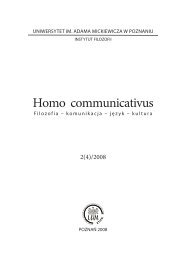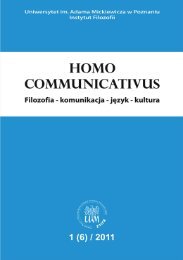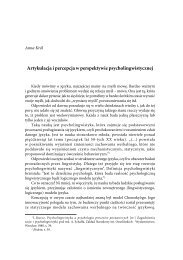76MARIETTA RADOMSKAbetween signifier and signified.” 15 We can thus deduce that every synonym of“animal” (such as e.g. “beast”)has its full meaning and significance. In that wayDario Martinelli pointed out eight connotations of the word “animal” withinwestern culture. So we can observe animal as “any other animal except humans”,as referred to exclusively human characteristics (human as a “political animal”), toa particularly uncivilised human being , to aggressive and/ or violent attitudes(“cruel beast”), natural and/ or instinctive attitudes, to remarkable physical (mostlysexual) performances, to the ability of human being to adapt to a certain context(“stage animal”) or a zoomorphic non existent creature (e.g. unicorn). Each case isprovided with ethical nuance – it seems easy to conclude that (mostly in first fourdescriptions) cultural distances between human being and non-human animalswith associated with them conventionally negative and unacceptable behaviour.Surprisingly “animal” may be a general word within each community (within oneculture) but it becomes a particular one when considered cross-culturally.Furthermore, meaning of this word emerges from a textual and contextualinteraction, e.g. mussels are something else for the zoologist and for the gourmet.Apart from the concept of animal, another interesting issue is the one conceivingforms of human – animal other relationship. It was T. Seboek who emphasized theimportance of a general set of different kinds of motivation that push human beingsto interact with other animals, i.e. adaptation (or even anthropisation), progress(scientific/ technological), work (non-human animals as a part of productive cycle),needs (eating, wearing animals), pleasure (exploiting animals in order to satisfyhedonistic wishes – includes: zoos, pets, cartoons,etc.), tradition and culture(religion, myth,etc.) and daily life as a super-category including all other pointsfrom the list above. Dario Martinelli in his essay on forms of human-animalrelationship broadened the range of possible categories. 16The question of zoomusicologyNevertheless we are to proceed now to the issue of a fairly new concept –zoomusicology, the term which for the first time appeared in Francois BernardMâche’s essay Music, Myth, Nature in 1992. Thus one can see that such researchis not well defined yet, has very few scientific precedents and how little has beensaid about its subject until now. Dario Martinelli, Guest Professor at the FinnishNetwork University of Semiotics, conducting studies in the zoomusicology, triesto define it as a discipline considering “the aesthetic use of sound communication15Thomas Sebeok, Come comunicanogli animali che non parlano, ed. By Susan Petrilli, Editzionidel Sud, Bari 1998, p. 67; quotation available on website: http://www.zoosemiotics.helsinki.fi/animal.<strong>pdf</strong>16On website: http://www.zoosemiotics.helsinki.fi/animal.<strong>pdf</strong>
ZOOSEMIOTICS AS ...77among animals” 17 . He uses “sound communication” instead of “music”, reservingthe latter to just human music and “aesthetic” according to recent tendencies toacknowledge the existence of an aesthetic sense in animals. The concept of“aesthetics” constitutes as well the fundamental presupposition for defining musicas such. Moreover, Martinelli perceives music as a semantic and syntactic system.If we pose a question about the purpose of such discipline as zoomusicology,F. B. Mâche provides an answer: “if it turns out that music is a wide spreadphenomenon in several living species apart from man, this will very much callinto question the definition of music, and more widely that of man and his culture,as well as the idea we have of the animal itself.” 18 Scientists reveal quite frequentlysome new discoveries conceiving e.g. common routes of human music and loudcalls of modern apes. 19ConclusionIt is hard to escape the obvious conclusion that none of examined abovedisciplines has its full rights status, being defined, provided with its ownmethodology and considered as an autonomous field of research. Nevertheless,e.g. biosemiotics is conceived as a actual discipline substantially more thanzoomusicology. The latter approaches non-human animals from the direction ofhuman sciences, and music – on the contrary – from the direction of naturalsciences. That is likely to implicate the changes of perspective and revision of thewhole conception of the nature–culture dichotomy, also according to Ch. S. Peirce.Zoomusicology suggests as well that music is not exclusively a human phenomenon,but rather an emotion and instinct-based one, as Dario Martinelli writes. Moreover,he places anthropomusicology within the area of zoomusicology, not in theopposition. Even if we have some reservations towards these new disciplinesconsidering mainly the issue of communication and meaning, especially the latterwhich is hard to call (an autonomous) discipline, it is difficult to resist the conclusionthat new fields of studies encourage progress of human knowledge in studyingother animals, the attitude towards them. Considered branches of semiotics changeas well as the attitude towards the communication within the natural environment.To conclude, each of conceived disciplines has indeed its positive impact onbroadening our perspective.17On website: http://www.zoosemiotics.helsinki.fi/zm/welcome.htm18Francois Bernard Mâche, Music, Myth and Nature or The Dolphines of Arion, Harwood AcademicPublishers, Chur 1992, p. 95; quotation available on website: http://www.zoosemiotics.helsinki.fi/zm/welcome.htm19On website: http://www.zoosemiotics.helsinki.fi/zm/music_and_primates.htm
- Page 1 and 2:
HomoCOMMUNICATIVUSFilozofia - komun
- Page 3 and 4:
Redaguje zespółRedaktor naczelny
- Page 5 and 6:
Słowo wstępnePrzed kilku laty pow
- Page 7 and 8:
Drodzy Czytelnicy,Z radością, ale
- Page 9:
Emanuel KulczyckiJęzyk a podróżP
- Page 12 and 13:
12EMANUEL KULCZYCKIrozważając asp
- Page 14 and 15:
14EMANUEL KULCZYCKIjęzykach: „Po
- Page 16 and 17:
Łukasz WiśniewskiFilozofia po Aus
- Page 18 and 19:
18ŁUKASZ WIŚNIEWSKIdrodze ,,rozum
- Page 20 and 21:
20ŁUKASZ WIŚNIEWSKImonarchie ich
- Page 22 and 23:
22ŁUKASZ WIŚNIEWSKIJeana - Franç
- Page 24 and 25:
24ŁUKASZ WIŚNIEWSKItylko jedną,
- Page 26 and 27: 26ŁUKASZ WIŚNIEWSKIzaufał człow
- Page 28 and 29: Magadalena SkorczykSymbol, mit, met
- Page 30 and 31: 30MAGDALENA SKORCZYKo języku w kat
- Page 32 and 33: 32MAGDALENA SKORCZYKważnym składn
- Page 34 and 35: 34MAGDALENA SKORCZYKgenezy języka
- Page 36 and 37: 36MAGDALENA SKORCZYKi potrzeby. Now
- Page 38 and 39: Dominika ŁukoszekFood, pets or god
- Page 40 and 41: 40DOMINIKA ŁUKOSZEKan economic suc
- Page 42 and 43: 42DOMINIKA ŁUKOSZEKperson feels an
- Page 44 and 45: 44MAGDALENA FOŁDAkomunikację nie
- Page 46 and 47: 46MAGDALENA FOŁDAi zazwyczaj nale
- Page 48 and 49: 48MAGDALENA FOŁDAdogadują sobie i
- Page 50 and 51: 50MAGDALENA FOŁDAna to nie godzi)
- Page 52 and 53: 52MAGDALENA FOŁDAtego „jak” dz
- Page 54 and 55: Anna KrólArtykulacja i percepcja w
- Page 56 and 57: 56ANNA KRÓLdźwięków, które mog
- Page 58 and 59: 58ANNA KRÓLartykułowane niestaran
- Page 60 and 61: 60ANNA KRÓLneuroakustycznym. Dalej
- Page 62 and 63: Juliusz IwanickiKultura materialna
- Page 64 and 65: 64JULIUSZ IWANICKI• panowanie bry
- Page 66 and 67: 66JULIUSZ IWANICKIwarunków do harm
- Page 68 and 69: 68JULIUSZ IWANICKITak więc, w świ
- Page 70 and 71: 70JULIUSZ IWANICKIMimo wszystko, dy
- Page 72 and 73: 72MARIETTA RADOMSKAexpectations”
- Page 74 and 75: 74MARIETTA RADOMSKAZoosemiotics as
















